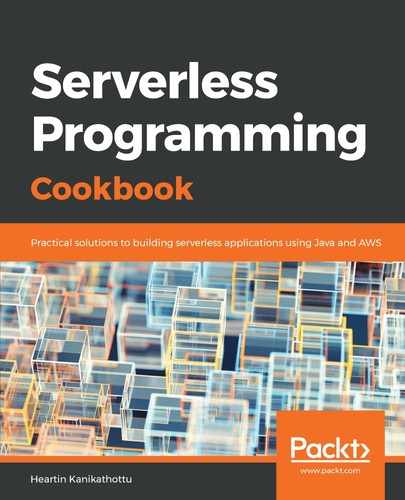Let's create an API with CORS enabled from scratch. Steps 1 to 4 are the same as we have seen in Chapter 2, Building Serverless REST APIs with API Gateway:
- Create an API:
aws apigateway create-rest-api
--name 'API WITH CORS'
--region us-east-1
--profile admin
- Get the ID of the root resource path :
aws apigateway get-resources
--rest-api-id xenqybowjg
- Create a resource greeting under the root path:
aws apigateway create-resource
--rest-api-id xenqybowjg
--parent-id p8yd8xde55
--path-part greeting
- Create a subresource with a path parameter that can accept a string:
aws apigateway create-resource
--rest-api-id xenqybowjg
--parent-id xkjhh7
--path-part "{name}"
- Next, we will create the GET method:
-
- Execute put-method for the GET method:
aws apigateway put-method
--rest-api-id xenqybowjg
--resource-id sfgfk6
--http-method GET
--authorization-type "NONE"
-
- Execute put-method-response for the GET method:
aws apigateway put-method-response
--rest-api-id xenqybowjg
--resource-id sfgfk6
--http-method GET
--status-code 200
--response-parameters file://put-method-response-get.json
put-method-response-get.json should look as follows:
{
"method.response.header.Access-Control-Allow-Origin": false
}
-
- Execute put-integration for the GET method:
aws apigateway put-integration
--rest-api-id xenqybowjg
--resource-id sfgfk6
--http-method GET
--type MOCK
--integration-http-method GET
--request-templates "{"application/json": "{"statusCode": "200"}"}"
-
- Execute put-integration-response for the GET method:
aws apigateway put-integration-response
--rest-api-id xenqybowjg
--resource-id sfgfk6
--http-method GET
--status-code 200
--response-templates file://response-template-get.json
--response-parameters file://put-method-integration-get.json
--selection-pattern ""
--region us-east-1 --profile admin
The response-template-get.json file should have the following contents:
{"application/json": "Hello $input.params('name')"}
The put-method-integration-get.json file should have the following contents:
{
"method.response.header.Access-Control-Allow-Origin": "'*'"
}
- Now, we will create the OPTIONS method:
-
- Execute put-method for the OPTIONS method:
- Execute put-method for the OPTIONS method:
aws apigateway put-method
--rest-api-id xenqybowjg
--resource-id sfgfk6
--http-method OPTIONS
--authorization-type "NONE"
-
- Execute put-method-response or the OPTIONS method:
aws apigateway put-method-response
--rest-api-id xenqybowjg
--resource-id sfgfk6
--http-method OPTIONS
--status-code 200
--response-parameters file://put-method-options.json
put-method-options.json should look like this:
{
"method.response.header.Access-Control-Allow-Origin": false,
"method.response.header.Access-Control-Allow-Headers": false,
"method.response.header.Access-Control-Allow-Methods": false
}
-
- Execute put-integration for the OPTIONS method:
aws apigateway put-integration
--rest-api-id xenqybowjg
--resource-id sfgfk6
--http-method OPTIONS
--type MOCK
--integration-http-method OPTIONS
--request-templates "{"application/json": "{"statusCode": "200"}"}"
-
- Execute put-integration-response for the OPTIONS method:
aws apigateway put-integration-response
--rest-api-id xenqybowjg
--resource-id sfgfk6
--http-method OPTIONS
--status-code 200
--response-parameters file://put-method-integration-response-options.json
--selection-pattern ""
The put-method-integration-response-options.json file should contain the following content:
{
"method.response.header.Access-Control-Allow-Origin": "'*'",
"method.response.header.Access-Control-Allow-Headers": "'Content-Type,Authorization,X-Amz-Date,X-Api-Key,X-Amz-Security-Token'"
}
- Deploy the API:
aws apigateway create-deployment
--rest-api-id xenqybowjg
--stage-name dev
--stage-description "Dev stage"
--description "Dev deployment"
Execute the following URL from the browser: https://xenqybowjg.execute-api.us-east-1.amazonaws.com/dev/greeting/Heartin.
- Execute the URL from CodePen as follows:
var xhr = new XMLHttpRequest();
xhr.open('GET', 'https://qngs4lsxob.execute-api.us-east-1.amazonaws.com/dev/greeting/Heartin');
xhr.onreadystatechange = function (event) {
console.log(event.target.response);
}
xhr.setRequestHeader('Content-Type', 'application/json');
xhr.send();
In the Chrome developer console, we should now see a success message as follows, instead of the errors we saw in the Getting ready section.

